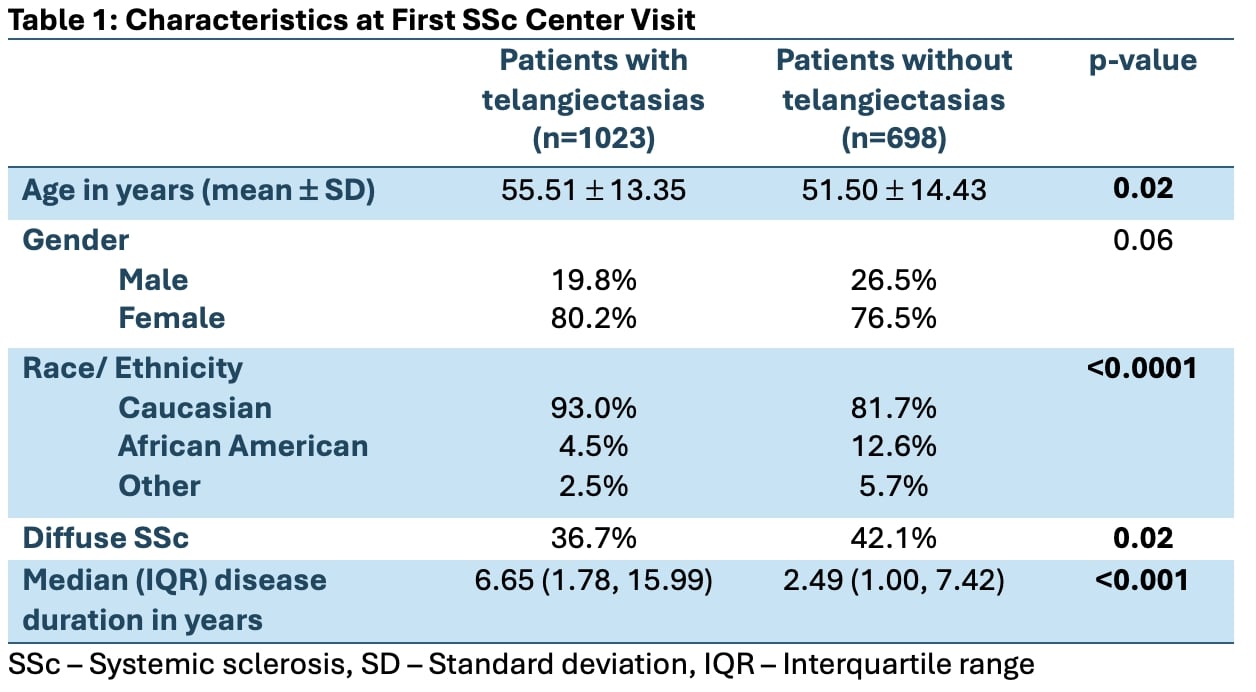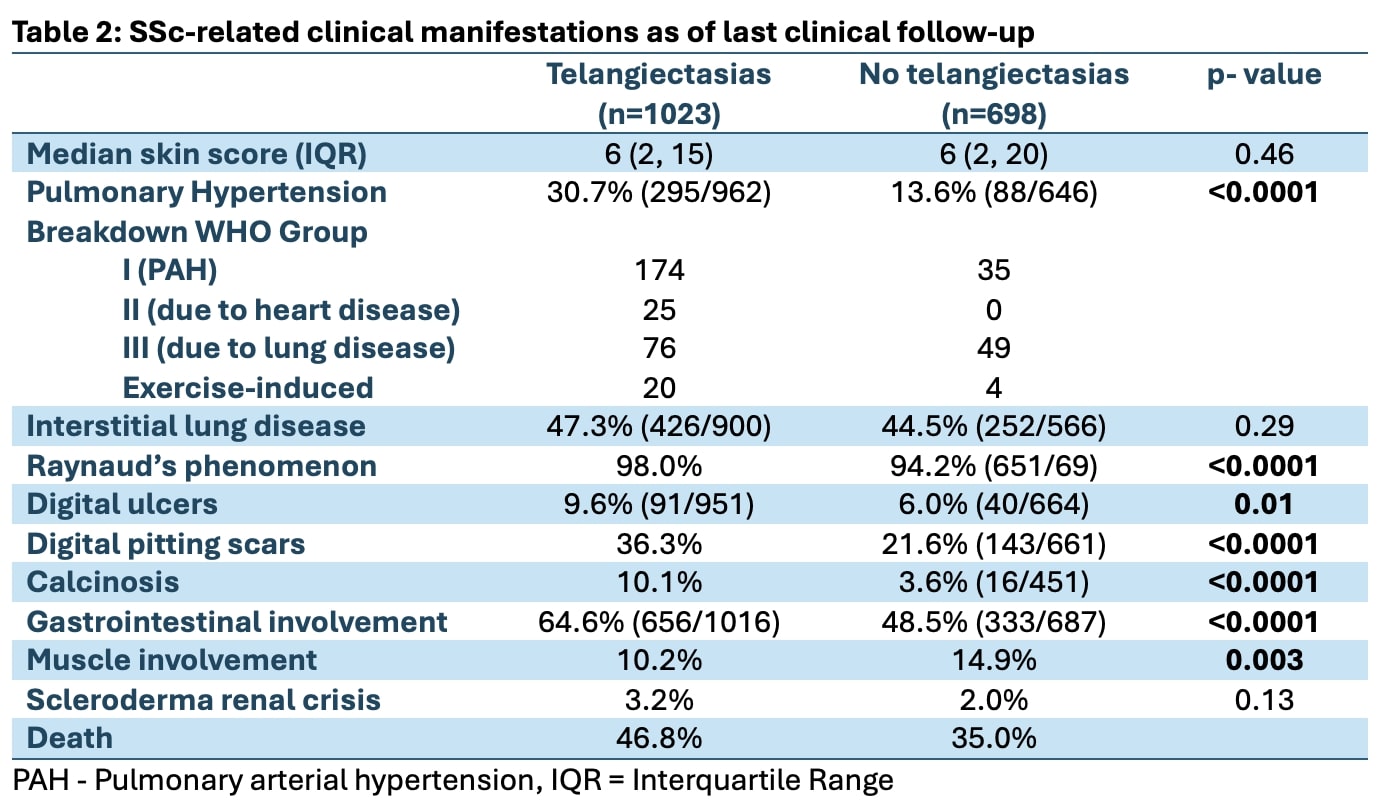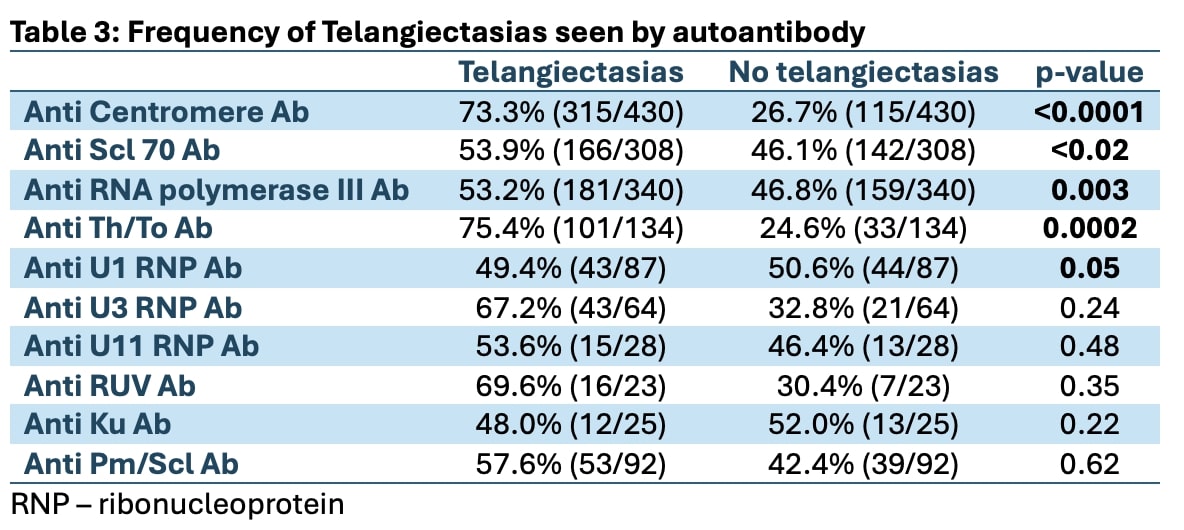Session Information
Session Type: Poster Session C
Session Time: 10:30AM-12:30PM
Background/Purpose: Telangiectasias (Tel) are visibly dilated cutaneous post-capillary venules reported to occur in about 75% of patients with systemic sclerosis (SSc), making them a common disease-specific manifestation of SSc (Ferreli et al). Although initially thought to be a hallmark of CREST syndrome and more common in limited SSc, Tel can increase in number over time in diffuse SSc as well. Prior studies have linked Tel with disease duration, pulmonary hypertension (PH) and digital ulcers (DU). Our aim was to explore associations of Tel with autoantibodies (Ab) and clinical manifestations in SSc.
Methods: SSc patients presenting as a new patient visit between 2000 and 2020 were consented for a prospective observational cohort study at a single-institution scleroderma center. Ab at first visit were assessed by immunofluorescence, immunodiffusion and immunoprecipitation. Patients were grouped by the presence or absence of Tel as of their last visit. Statistical analyses were performed using SAS software. Chi-square, t-tests, Wilcoxon, Kaplan-Meier and Cox proportional hazards were used for group comparisons.
Results: Out of 1721 patients eligible, 1023 patients (59%) had Tel while 698 (41%) did not as of their last visit. The mean age in years at 1st visit was older in patients with Tel at 55.5 versus 51.5 in those with no Tel (p = 0.02). Patients with Tel were more frequently Caucasian (p = < 0.0001) and had a longer median disease duration at presentation (p < 0.001) (Table 1). Ab analysis showed that significantly more patients with ACA and Th/To Ab ( >70%) developed Tel, with 53% of Scl70+ and RNA polymerase III+ patients also developing Tel (Table 3). As of last follow-up, patients with Tel had higher frequencies of PH, RP, digital pitting scars (DPS), DU and calcinosis as well as gastrointestinal involvement (Table 2). Muscle involvement was more frequent in the non-Tel group (Table 2). Survival at 5 years was lower in the Tel group (p < 0.0001) and persisted after adjustment for age, gender and diffuse disease.
Conclusion: Microvascular dysfunction plays a key role in the pathogenesis and complications of SSc. Tel potentially reflect microvascular changes in SSc, and may result from an aberrant attempt at increasing blood perfusion to hypoxic tissues, lacking normal circulation. Our study confirms the association of Tel with the presence of PH, RP and DU, as found in other studies, but also reports associations with DPS and calcinosis, all of which may be related to SSc microangiopathy, thus reiterating the role of Tel as a surrogate marker for ongoing vascular injury. There is a higher prevalence of SSc-related gastrointestinal manifestations, which may be from a fibroproliferative vasculopathy, among patients with Tel. Additionally, patients with ACA, RNA polymerase III and Th/To Ab, which have been associated with a higher incidence of PH and cutaneous obliterative manifestations, also commonly developed Tel, further pointing towards the association of Tel with clinical manifestations of SSc, that carry an overall poorer prognosis. Although further studies are required, our study highlights the association between Tel and disease-specific manifestations and its potential clinical utility as a prognostic marker.
To cite this abstract in AMA style:
Nair N, Medsger, Jr T, Lafyatis R, Laffoon M, Freno L, Domsic R. Association of Telangiectasias with Autoantibodies and Clinical Manifestations in Systemic Sclerosis [abstract]. Arthritis Rheumatol. 2024; 76 (suppl 9). https://acrabstracts.org/abstract/association-of-telangiectasias-with-autoantibodies-and-clinical-manifestations-in-systemic-sclerosis/. Accessed .« Back to ACR Convergence 2024
ACR Meeting Abstracts - https://acrabstracts.org/abstract/association-of-telangiectasias-with-autoantibodies-and-clinical-manifestations-in-systemic-sclerosis/



